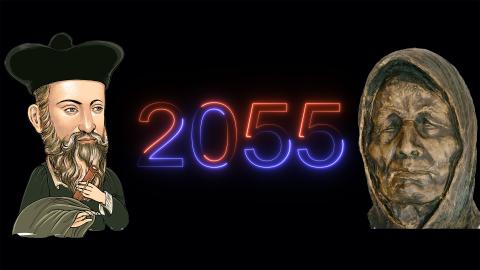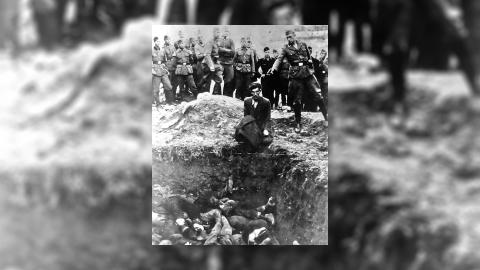Were the Templars secret devil worshippers?
In the new season of Knightfall, Landry du Lauzon and his fellow Templars face the greatest threat to their order so far, as a plot is hatched to discredit their order by framing them as worshippers of dark and diabolical idols.
Of course, the real Templars were indeed accused of indulging in strange rituals and sinister heresies when their members were rounded up, put on trial and executed in the early 14th Century. An ominous word emerged, supposedly referring to a demonic deity the Templars worshipped. That word was Baphomet, which has since come to be regarded as a synonym for Satan, often pictured as a horned, goat-headed entity. Were the Knights Templar, an order of warrior-monks famed for their Christian piety, really a rabble of devil worshippers?
Baphomet’ was simply a corrupted version of ‘Mahomet’, an old French word referring to Muhammad, the founder of Islam
To understand the truth, we have to unravel the surprising history of Baphomet itself. Because, despite popular misconceptions, Baphomet had absolutely no association with Satan until well into the 20th Century.
The word first turned up in a letter of 1098 written by a certain Anselm of Ribebont, who fought in the First Crusade. Describing the lead-up to a clash with Muslim soldiers, he wrote how ‘as the next day dawned, they called loudly upon Baphometh’ and we prayed silently in our hearts to God’. The context of the word here, along with other evidence from the First Crusade, heavily suggests that ‘Baphomet’ was simply a corrupted version of ‘Mahomet’, an old French word referring to Muhammad, the founder of Islam.
But why was the word allegedly mentioned by various knights after they were arrested during the crackdown on the Templars by King Philip IV of France? While being ruthlessly tortured, the knights confessed to spitting on the cross, being made to deny Christ and worshipping idols including severed, mummified heads. These accounts were garish, varied and often contradictory, with the words ‘Baphomet’ and ‘Mahomet’ being linked to these alleged idols. According to the testimony of an unnamed Italian Templar, for example, one of his fellow knights showed him an idol and said, ‘Adore this head. This head is your God and your Mahomet’.
Many scholars subscribe to the theory that such stories weren’t merely false confessions used to smear the Templars. Instead, the Templars may have been ordered to renounce Christ, worship idols and pledge allegiance to Muhammad as a kind of POW training, simulating the ordeals they might have to endure if they were captured by the enemy.
But what if Baphomet had nothing to do with Muhammad? There have been attempts to see the word as evidence the Templars were actually secret Gnostics, adhering to ancient schools of thought which were regarded as horrific heresies by the Catholic Church. Gnostic beliefs encompassed various blasphemous ideas, such as the God of the Old Testament being an evil force, all material reality being corrupt, and Jesus Christ never having had a physical body at all.
Such ideas returned to prominence in medieval Europe with the rise of the Cathars, a neo-Gnostic movement that became – for the Catholic Church – worryingly powerful in southern France. The Cathars were brutally persecuted and suppressed, much like the Templars themselves were.
Could the Templars have shared Cathar beliefs? Some have certainly suggested that ‘Baphomet’ is the dead giveaway. Joseph von Hammer-Purgstall, a 19th Century historian and expert on Middle Eastern literature, believed that the word ‘Baphomet’ derived not from Mahomet, but from a combination of Greek words meaning ‘baptism of the spirit’. Von Hammer-Purgstall took this to refer to Gnostic rituals of secret knowledge. He also pointed out ‘evidence’, such as medieval medals, vases and figurines emblazoned with arcane symbols, which he claimed was proof the Templars were neo-Gnostics.
Not everyone was convinced. Writing about this theory, a 19th Century historian of the Crusades called Joseph Francois Michaud bluntly said: ‘No relation presents itself, either near or remote, with the Templars’. The 20th Century historian Peter Partner also suggested the relics and figurines ‘may have been forgeries from occultist workshops’.
Yet, the Gnostic connection was given a new lease when Dr Hugh Schonfield, one of the scholars who analysed the Dead Sea Scrolls after they were discovered in the 1940s, applied the Herbew Atbash cipher to the word ‘Baphomet’. The Atbash cipher is a simple substitution cipher which was used to encode words by replacing each letter of the alphabet with another. Schonfield believed the cipher revealed Baphomet to be a coded translation for ‘Sophia’, a divine figure in Gnostic mysticism.
But what about the winged goat-creature that springs to mind when most people think of Baphomet? Well, this adds yet another layer of complexity and confusion to the whole Baphomet legend, because – far from being some ancient and eerie symbol from long ago – this iconic image of Baphomet was abruptly invented by one man, a French occultist named Éliphas Lévi, in the mid-19th Century.
It was Lévi who made up the winged goat-creature version of Baphomet, considering it ‘a pantheistic and magical figure of the Absolute’ rather than a representation of Satan. Each part of the image had symbolic significance for Levi, as he drew inspiration from Greek mythology (such as the half-goat deity Pan) as well as attributes of the divine set out by Kabbalah, a school of Jewish mysticism.
Lévi’s Baphomet, which basically had nothing to do with the enigmatic Baphomet of the Templars, was adopted as a figurehead by the notorious occultist Aleister Crowley, who in the early 20th Century founded a mystical movement called Thelema. Like Lévi, Crowley saw Baphomet as a grand encapsulation of opposing forces, including the masculine and the feminine. Crowley saw nothing devilish about the image, as he rejected Christian doctrine and the Christian conception of Satan.
Similarly, even though Baphomet became part of the imagery of the Church of Satan, formed by American occultist Anton LaVey in the 1960s, it’s important to note the Church of Satan is actually an atheistic organisation which doesn’t believe in an actual, ‘living’ Satan, and simply uses the imagery for its symbolic value.
With all these conflicting mythologies and schools of thought swirling around the word Baphomet, it’s no wonder this figure has become a key component of conspiracy theories throughout the ages. Whether mentioned in connection to the Gnostics, the Freemasons, the alleged ‘Illuminati’ or other shadowy forces accused of secretly ruling the world, Baphomet has always meant whatever any conspiracy theorist has wanted it to mean. And it still does today, more than 700 years after tortured Templars unwittingly gave life to the legend.
















